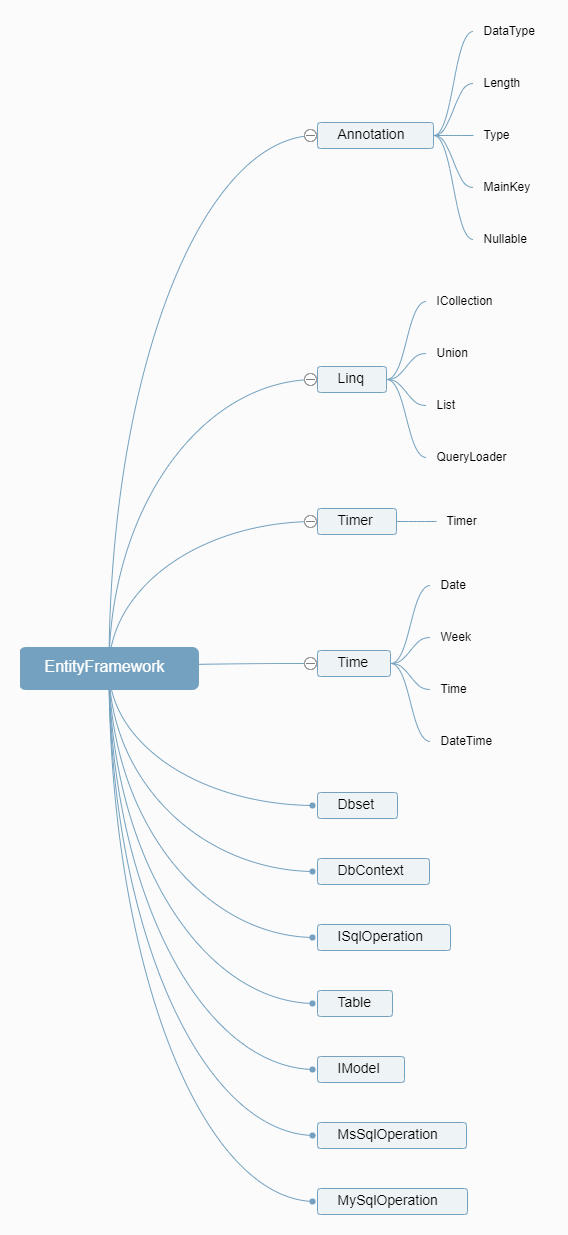代码演示
表结构
TBUser
| 字段名 | 类型 | 备注 |
|---|---|---|
| Guid | int | 主键,非空 |
| Name | nchar(10) | 名称 |
TBInfo
| 字段名 | 类型 | 备注 |
|---|---|---|
| Guid | int | 主键,非空 |
| Age | int | 年龄 |
| Score | int | 分数 |
DatabaseFirst
模型类


public class TBUser implements IModel {
public int Guid;
public String Name;
}
public class TBInfo implements IModel {
public int Guid;
public int Age;
public int Score;
}
PS:在模型类中,默认主键为第一个元素
上下文类
public class MyContext extends DbContext {
public MyContext() throws Exception {
onCreate();
}
public DbSet<TBUser> TbUser = new DbSet<>(TBUser.class);
public DbSet<TBInfo> TbInfo = new DbSet<>(TBInfo.class);
@Override
protected void onCreate() throws Exception {
this.useSqlOperation(MySqlOperation.useDefault());
this.run();
}
}
所有上下文需要继承DbContext,然后把所有的表模型初始化到DbSet中,记得重写onCreate函数
| 函数名 | 参数 | 用途 |
|---|---|---|
| useSqlOperation | IOperation | 初始化SQL连接对象,并对所有的DbSet进行初始化注入 |
| run | 初始化DbSet池,载入数据库的元素 | |
| build | 进行CodeFirst创建数据库 |
实例化使用
先创建5条User数据
public class Main {
public static void main(String[] args) throws Exception {
MyContext context = new MyContext();
context.TbUser.add(new TBUser(0, "Alice"));
context.TbUser.add(new TBUser(1, "Bob"));
context.TbUser.add(new TBUser(2, "Elima"));
context.TbUser.add(new TBUser(3, "Win"));
context.TbUser.add(new TBUser(4, "Gin"));
context.saveChanges();
}
}
查看这5条数据
public class Main {
public static void main(String[] args) throws Exception {
MyContext context = new MyContext();
var result = context.TbUser
.select(s->String.format("%s的编号为%d", s.Name, s.Guid));
QueryLoader.StdOutput(result);
}
}
>>>>>
Alice的编号为0
Bob的编号为1
Elima的编号为2
Win的编号为3
Gin的编号为4
进程已结束,退出代码0
我们生成一部分的TbInfo
public class Main {
public static void main(String[] args) throws Exception {
MyContext context = new MyContext();
Random random = new Random();
context.TbUser
.where(s -> s.Name.length() <= 3 || s.Name.startsWith("A"))
.select(s -> new TBInfo(s.Guid, random.nextInt(30), random.nextInt(100)))
.toList()
.forEach((Consumer<? super TBInfo>) s -> {
try {
context.TbInfo.add(s);
} catch (Exception e) {
throw new RuntimeException(e);
}
});
context.saveChanges();
}
}
我们先查询到Elima的数据并删除它
public class Main {
public static void main(String[] args) throws Exception {
MyContext context = new MyContext();
var elima = context.TbUser.where(s->s.Name.equals("Elima")).firstOrDefault();
//var elima = context.TbUser.firstOrDefault(s->s.Name.equals("Elima")); 同样可以使用
context.TbUser.remove(elima);
context.saveChanges();
}
}
然后我们联合查询一下两张表,使用join函数,并更新Score排序
public class Main {
public static void main(String[] args) throws Exception {
MyContext context = new MyContext();
var result = context
.TbUser
.join(context.TbInfo,
s->s.Guid,
s->s.Guid,
s->s)
.orderBy(s->s.B.Score)
.reverse()
.select(s->String.format("编号%d的名称为%s,年龄为%d,得分为%d",s.A.Guid,s.A.Name,s.B.Age,s.B.Score));
QueryLoader.StdOutput(result);
}
}
>>>>>
编号1的名称为Bob,年龄为3,得分为67
编号3的名称为Win,年龄为18,得分为56
编号0的名称为Alice,年龄为15,得分为36
编号4的名称为Gin,年龄为14,得分为25
进程已结束,退出代码0
CodeFirst
模型类
首先构建模型类
public class TBUser implements IModel {
@MainKey
@Type(type = DataType.integer)
public int Guid;
@Type(type = DataType.nchar, length = 10)
@Nullable
public String Name;
public TBUser(){}
public TBUser(int guid, String name){
Guid = guid;
Name = name;
}
}
public class TBInfo implements IModel {
@MainKey
@Type(type = DataType.integer)
public int Guid;
@Type(type = DataType.integer)
@Nullable
public int Age;
@Type(type = DataType.integer)
@Nullable
public int Score;
public TBInfo(){}
public TBInfo(int guid, int age, int score){
Guid = guid;
Age = age;
Score = score;
}
}
@MainKey唯一指定,主键
@Nullable可空类型
@Length字符类型的指定长度
@Type指定字段类型
目前支持的类型有
- nchar
- int
- datetime
- varchar
上下文类
与DatabaseFirst相比,有一点差距就是onLoad的重写,其他都是一样的
@Override
protected void onCreate() throws Exception {
this.useSqlOperation(MySqlOperation.useDefault());
this.build();
this.run();
}
实例化使用
public class Main {
public static void main(String[] args) throws Exception {
MyContext context = new MyContext();
}
}


创建成功后,请把onCreate中删除build语句,不然会重复创建报错
后续操作与DatabaseFirst相同
项目结构

具体下载链接见后续帖子,或者留言私信作者…
持续更新中…
本文含有隐藏内容,请 开通VIP 后查看